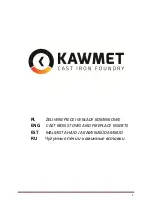
Page 32
Installation and Operation Manual - FW3200
ENGLISH
8.2 Floor Protection
This stove is designed to prevent the floor from overheating. However, it must be placed on a
nonflammable surface to protect the floor from hot embers that may fall during loading.
The floor protection must be a continuous, non combustible material, such as steel with a
minimum thickness of 0.015" (0.38 mm) or ceramic tiles sealed together with grout. Cement
board, brick, or any other approved or listed material suited for floor protection. No R factor
required.
Any type of tile will require a continuous non combustible sheet beneath to prevent the possibility
of embers falling through to the combustible floor if cracks or separation should occur in the
finished surface. Check local codes for approved alternatives.
No protection is required if the unit is installed on a non-combustible floor (ex: concrete).
FLOOR PROTECTION
Canada
USA
G
18
8" (203 mm)
N/A
H
8" (203 mm)
N/A
I
18" (457 mm)
From door
opening
16" (203 mm)
From door
opening
J
N/A
8" (203 mm)
N
19
N/A
See Note 2
H
I
G
J
Floor Protection
8.3 Reducing Clearances Safely
It is often desired to use as little space as possible
when installing a wood stove. To do this, it is possible
to reduce the clearances safely and install the stove
closer to the walls by permanently installing a heat
shield between the stove and the flammable material.
The rules for heat shields are sometimes complicated.
Read and apply the instructions carefully. Some
regions may have different regulations. Consult the
local building code or contact the fire department for
restrictions, inspection and installation requirements in
the area.
Heat shield
18
The floor protection at the back of the stove is limited to the stove’s required clearance if such clearance is smaller than 8 inches (203 mm).
19
Only required under the horizontal section (Ho) of the connector. Must exceed each side of the connector by at least 2 inches (51 mm).
See "Clearances - Ceiling"
















































